Interview for MoMA Magazine
Interview by Paola Antonelli, Amanda Forment & Prudence Pfeiffer for MoMA Magazine.
Photos by Naeem Douglas.
Interview by Paola Antonelli, Amanda Forment & Prudence Pfeiffer for MoMA Magazine.
Photos by Naeem Douglas.
On the occasion of my first painting exhibition at Upstream Gallery in Amsterdam, I sat down with art critic Robert van Altena for the Springvossen podcast. You can listen to the conversation here. (Sorry, Dutch only)
I find it difficult to write about my own work. Conversation is an easier way to formulate thoughts.
For me at least…
I had an in-depth conversation with Yuzo Ono, a haiku poet and writer from Japan.
We talked about the space between internet art, still life paintings, and haiku.
don’t make art on the internet, that will never work
don’t show websites in museums, they belong online
don’t make gallery objects, you’re a web artist
don’t write poetry, you’re not a poet
don’t use blockchain, that’s for investors
don’t paint, that’s for painters
less strategy 👉 more fun
less fear 👉 more joy
less meaning 👉 more energy
less limits 👉 more freedom
less stress 👉 more naps
less opinion 👉 more ideas
less worry 👉 more hope
less doubts 👉 more decisions
a fire?
a door?
a mystery?
an example?
a lightning rod?
a lifestyle?
a religion?
a waterfall?
a storm?
i made something, you should see it!
it is great because
– it represents the core of my being
– i worked on it for a long time
– i did a lot of research
– it will go up in value
– it will make the world a better place
– famous people love it
– i am aware of art history
empty pockets
empty phrases
empty gestures
empty calories
empty stomach
empty vessel
empty promise
empty threat
empty house
empty hard drive
empty fridge
empty wallet
empty table
empty bed
empty horizon
empty nester
empty page
empty time
empty mind
In the Before Times, art and culture were clearly separated by museum walls. Within those museum walls, artists kept asking what art is. Is this art? How about this? And this? As long as it happened inside those walls, the answer was always yes.
Now that art has to operate on the same screen as everybody else, the contextual privilege disappears. If you cover a museum wall with peanut butter, it’s art. But what if you do the same thing on Youtube?
Art is something different. There is culture, there is entertainment, and somewhere outside of that is art. Is that true? Is art different? Is art better?
Does art transcend the crowded realm of decoration and entertainment? Does art last longer? Does art show us our true selves? Does art break convention? When culture breaks convention, is it art?
When writing is exceptional, does it become art? When cooking is exceptional, does it become art? Can breathing be art?
Is art only that what is shown in museums? Does the word art mean anything? I’d like to believe there is something valuable that separates art from the rest but I’m not so sure.
free from expectation
free from distraction
free from approval
free from convention
free from obligation
free from utility
free from compromise
free from agreement
free from competition
free from hierarchy
free from fear
I don’t really understand the impulse to own art. I love empty spaces. I love being in an empty space. It is the most inspiring to me because there is nothing else to do except finding new ideas. Ownership is a prison of obligations. But I need your money so I can make whatever I want. Because you want to own I can create. I don’t judge your cravings, I am happy that you take on the burden of storage. Take it out of my hands so I can make something new.
Please take care of the work and give me some money so I can buy soba noodles and get back to work. Money makes me happy. Lots of money and few things. Money in the bank makes me feel free. I realize i’m not free at all. The more money I have the poorer I feel. The more there is to lose. I made good money this year, more than I ever have. I have no idea what to do with it other than to keep it in a jar and feed it. The money makes me feel safe yet i’m not.
art is the intensification of perception
art is the moment between realizing and understanding
art is research without aim
art is the area between thoughts and feelings
art is the tension between a personality and a material
art is not mysterious because there is no solution
art does not have any reason to exist
art comes from solitary curiosity
the serious artist does more thinking than doing
the serious artist provokes but does not offend
the serious artist knows everyone but doesn’t talk to anyone
the serious artist does not talk about money but has lots of it
the serious artist is a mystery
the serious artist does not give answers
the serious artist does not create
the serious artist does not explain
the serious artist edits
the serious artist knows how to say no
the serious artist doesn’t need you
the serious artist laughs only at the right jokes
the serious artist does not own a tv
the serious artist only travels for work
the serious artist does research
the serious artist enjoys encounters
the serious artist is often alone
the serious artist avoids public transportation
the serious artist rarely smiles
the serious artist is concerned
the serious artist questions authority
the serious artist is comfortable around power
the serious artist is great at dinners
the serious artist dresses in black
“Exhibiting the internet“, an interview with Adina Glickstein for Spike Art.
We talk about domain names, nfts, exhibitions and opportunities.
A conversation with Brandon Stosuy for The Creative Independent.
We talk about process and inspiration.
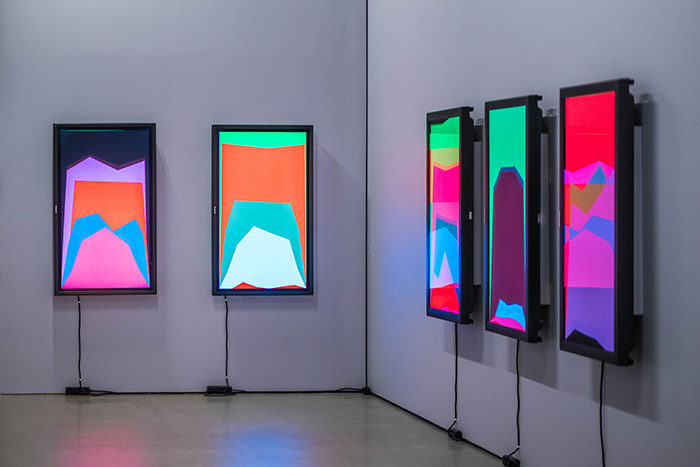
photo by Petter Cohen
Insomnia, Bonniers Konsthall, 2016
24 September 2016 – 22 January 2017
The group exhibition Insomnia discusses sleeplessness as a cultural symptom. It brings together a group of contemporary artists – Carsten Höller, Katarina Löfström, Julia Feyrer & Tamara Henderson, Kate Cooper, Leif Elggren and Rafaël Rozendaal – and a selection of historical works. The artists set the stage for states of sleep and wakefulness, rest and activity, dream-filled absence and constant accessibility, and the works keep Bonniers Konsthall active around the clock.
Essay by Marti Manen
Functionality, Forget about Functionality
On Rafaël Rozendaal
“The art world is a bit like a video game – you get to know people, you get some coins and then you get to go to the next level, and then you get into the slightly bigger room with less furniture. At first you’re in the side room, then you’re in the main room, then you get in the magazine, etc. The rules are very set, you talk to this person, a biennale, then you get a gold star, then you get upgraded and get to speak to better curators – but then also the critics are harsher… So really, it’s just like Super Mario.”
Rafaël Rozendaal
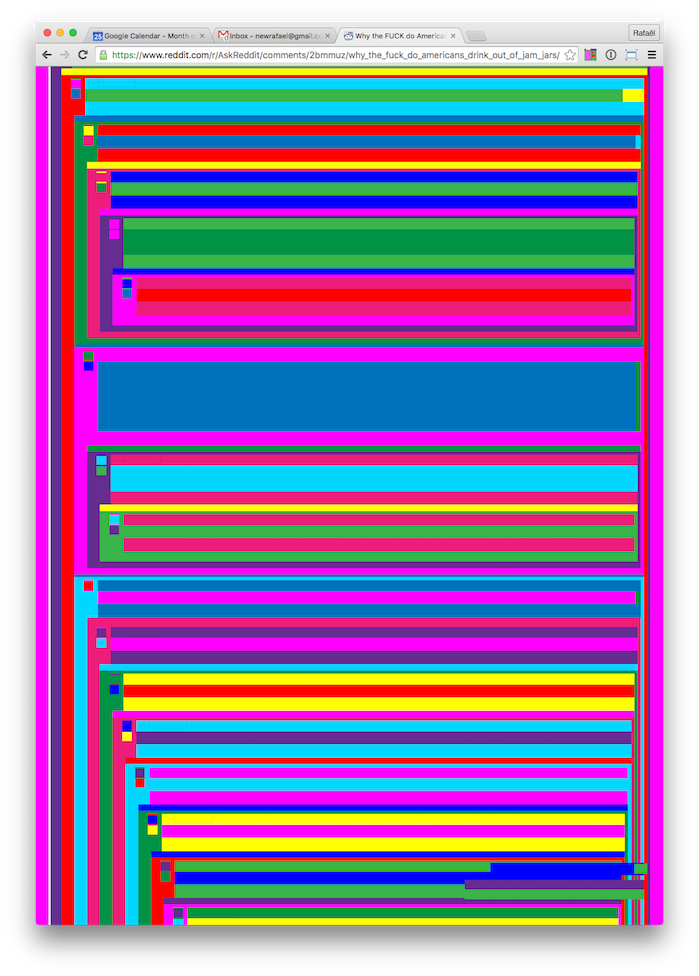
Abstract Browsing is a project that consists of both software and physical objects.
The browser plugin is a free software that anyone can install.
When you turn it on, you can surf the web but all web content is reduced to colored rectangles. It shows you the skeleton of the web. It’s like seeing an X-ray of a building, showing the structural elements.
Web pages are built of many smaller elements, information is organized and categorized. Text, images, tables, things we use every day but are not aware of.
I’m interested how our eyes move across the screen, how websites adapt, learn from your behavior, and change over time. Optimized to grab your attention, to never get boring, to tempt you to click and click and never leave.
Websites are constantly maximizing their efficiency, separate from aesthetic concerns. Websites learn from users by trial and error.
Technology asks new questions about composition. I’m looking for unusual compositions. Anti-compositions, unhuman compositions, compositions that humans would not have created on their own.
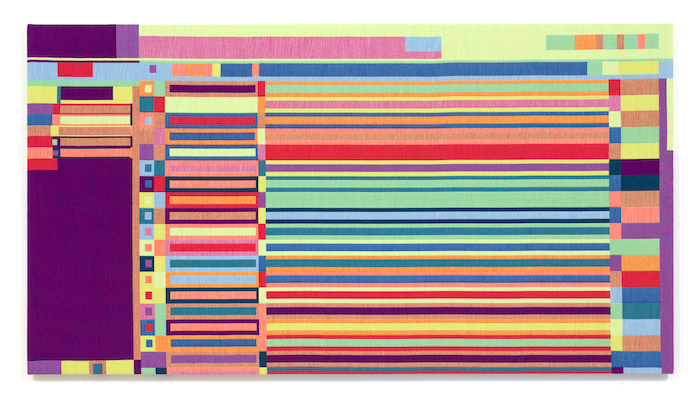
I surf the web every day using the plugin. Whenever I find a composition that strikes me, I take a screenshot. Just like digital photography, I take way too many images, thousands and thousands. The real challenge is editing. Making tapestries out of these compositions forces me to choose. Out of all the files I have, I have to choose which ones become objects.
The physicalization (weaving) brings focus. The software is fast and fluid, textile is expensive and slow. It slows me down, it helps me to pause and reflect.
I’ve tried to spend less time on the computer
turning procrastination into productivity
finding beauty in utility
abstraction => removal of information
from natural perception to material reduction
distraction based compositions
infinite information – infinite compositions
the aesthetics of distraction
abstraction is an escape
appropriated abstraction
weaving => mechanical painting
From Wikipedia
“The Jacquard head used replaceable punched cards to control a sequence of operations. It is considered an important step in the history of computing hardware. The ability to change the pattern of the loom’s weave by simply changing cards was an important conceptual precursor to the development of computer programming and data entry.
Charles Babbage knew of Jacquard looms and planned to use cards to store programs in his Analytical engine. In the late 19th century, Herman Hollerith took the idea of using punched cards to store information a step further when he created a punched card tabulating machine which he used to input data for the 1890 U.S. Census.”
ap·pro·pri·a·tion
əˌprōprēˈāSH(ə)n/
noun
the action of taking something for one’s own use, typically without the owner’s permission.
Is appropriation a form of bullying?
Instead of making something, taking something.
The appropriated one is usually not happy.
The villain is more interesting than the hero.
What does contextualize really mean?
– to bring focus
– to isolate
– to show something that is not art to an art audience
– to present something you did not make in an empty room
Appropriation deals with intellectual hierarchy.
Creation looks naïve next to appropriation.
at least i tried .org is a website with essays related to my haiku,
written by
Kayla Anderson
Haley Berkman
Margaret Carrigan
Marvin Jordan
Forrest Nash
curated by Seth Stolbun.
thank you all!
I was interviewed by Marvin Jordan for DIS magazine. We talk about the social, economic, and aesthetic conditions that characterize the landscape of internet-based art.
Very happy about this text, read it here.
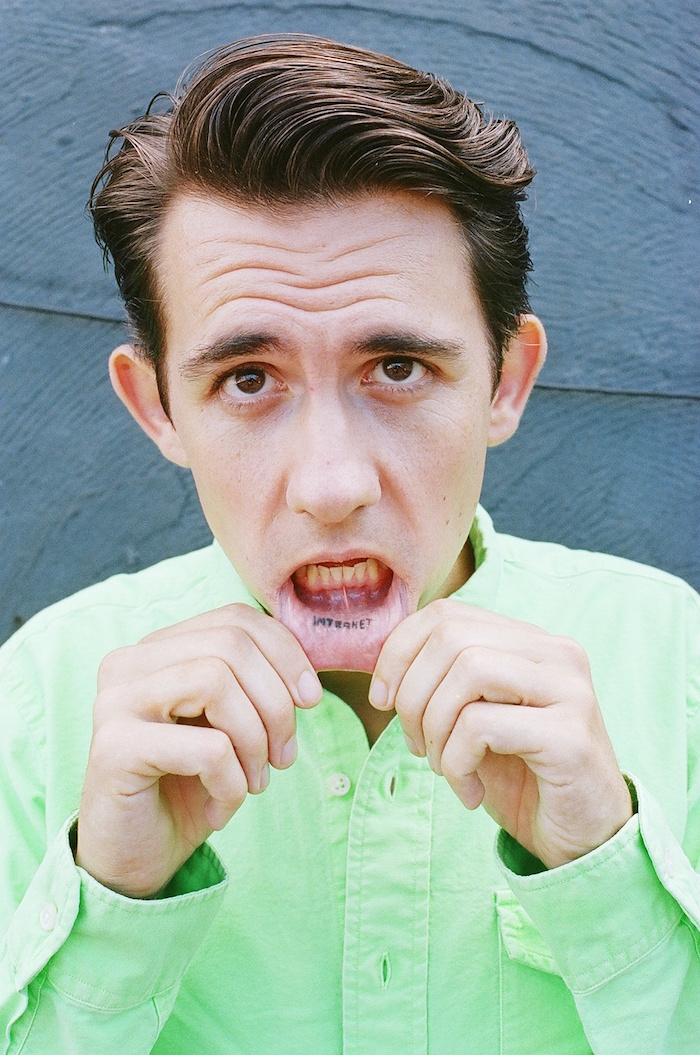
This is an archive of an article in Human Being Journal #5.
Text by Tag Christof, Photography by Clement Pascal.
In the early 1980s, Sherrie Levine gained notoriety for her groundbreaking exhibition After Walker Evans. She had photographed a number of the FSA master’s Great Depression-era photographs (notably all taken before she was born in 1947) and then hung and presented them, in all seriousness, as her original work. She had shot and developed the actual photos on display, so in a strictly ontological sense, the work was hers. But unlike earlier appropriation work, Levine made no attempt to disguise or alter the source. Instead, she made a game of subverting originality by calling it out in the exhibition’s title. The art world bristled. Was it still life? Was it original? Was it just shameless, lazy theft? And what did any of this mean for the value of a photograph as a piece of art?
Fast forward a few decades and art history has sided squarely with Levine. But the work of a new generation of digital artists is begging a similar set of questions around reproducibility, value and ownership. Rafae?l Rozendaal is among their foremost pioneers, having worked on the web prolifically since around the turn of the millennium. He trained as a conventional artist, but since 2001 has been buying up clever domain names on which to set up interactive artworks. The sites are singular — each contains one engaging scenario rendered in bright and proudly RGB palettes, and invites the user into a bit of unexpected usability. Among them are whitetrash.nl, pleasetouchme. com, hotdoom.com, beefchickenpork.com and several others.

Someone finds a trick to simplify a task. This person finishes the task faster and has more time to relax.
Once everyone starts using the same trick, there is no time to relax any more. You have to use the trick. What used to be normal is now slow.

This is a selection of texts from my Spheres book, in collaboration with Philippe Karrer.
When we stare at the ocean, we can’t see that far because of the curvature of the earth. Clouds are not that far away either. Stars can be very far away, but a lot of stars don’t even exist any more by the time their light hits our eyes. The further something is, the longer it takes before you see it.
People always emphasize it’s good to grow and innovate, but it’s also good to repeat and refine.
In the future, people will not carry around devices to access the internet. Instead, with a pocket knife, they will cut a rectangle out of thin air, right in front of them, and there the internet will be. Unfortunately, many people will leave pieces of sky on the floor which might be dangerous. (More…)
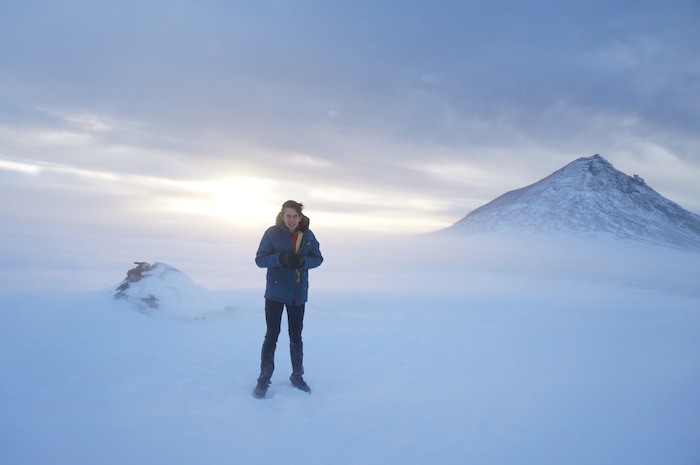
I cannot explain why, but one of my favorite activities in the world is throwing stuff away. After graduating, I started moving to different countries, so I had to. I could only take so much with me. Possessions restrict movement. I don’t need much.
I love the idea of empty spaces. I love visualizing an empty home with big windows in an empty landscape. I imagine windows opened on either side of the house, the wind blowing from miles away entering the house and leaving quickly, hardly obstructed.
Emptiness is very elegant. It is luxurious.
The reality is that I am never in an empty house in an empty landscape. I am always in very crowded places. I live in Chinatown New York which is dense with tourists and garbage. I travel in crowded airplanes and eat while my elbows touch the passenger next to me. I sleep in hotels packed with people and their luggage. I swim at crowded beaches and walk through crowded museums and sit in crowded subways.
Emptiness seems beautiful yet I hardly ever go there. I hardly make an effort. I could take a bus to the countryside and sit in an empty field for a few hours. I could but I don’t.
I like the idea of emptiness more than the reality of it.
it’s fun
it’s new
it’s light
it’s open
it’s cheap
it’s free
it’s everything
it’s always
it’s everywhere
no history
no stress
no boss
no budget
no deadlines
no hassle
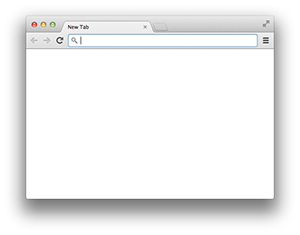
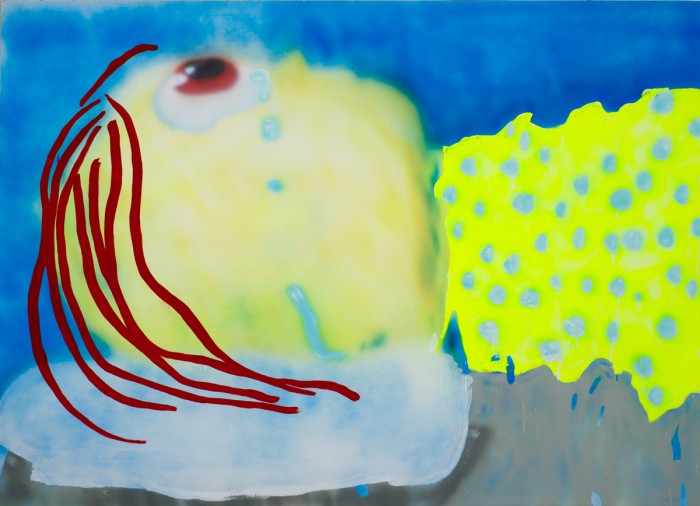
Austin Lee interviews Rafaël Rozendaal for SFAQ magazine.
New York, February 2014.
AL: Your artwork has strong ties to both painting and animation. How do you think about time in both mediums and how does it function in your work?
RR: I’m interested in movement, and I’m interested in staring. That means I want to make moving images that don’t have a beginning or ending, no specific duration. The computer makes it possible to create images that run infinitely, always a bit different but also kind of the same. Think of a fountain: it’s in motion, it’s moving, but it’s not going anywhere.
It lacks courage. It’s ugly. It’s conformist. It’s safe. It’s too easy. It’s decorative. It’s predictable. Deja vu. It’s obvious. It’s unoriginal. It lacks vision. It lacks emotion. It’s too emotional. It’s too personal. I don’t connect with it. It doesn’t surprise me. It’s dry. It’s pedantic. It’s too logical. It doesn’t make any sense. It makes too much sense. It’s repulsive. It’s nauseating. I hate it. More of the same. No innovation. It looks like vomit. It hurts my eyes. It makes me sad. It’s ignorant. It’s primitive. It’s banal. It’s too glossy. It’s too polished. It needs polishing. It lacks technique. It doesn’t do anything for me. It’s trendy. It won’t last. It’s fragile. It confuses me. It’s design. It’s theater. It’s illustration. It’s an effect. It lacks depth. It’s cold. There’s no content. There’s no concept. Too conceptual. It’s too pretty. There’s no narrative. It’s boring. It’s clumsy. It’s too much. It’s elitist. It’s populist. It’s crap. It’s not art. It’s too artistic. It’s vile. It lacks poetry. I don’t believe in it. It’s empty. It’s awful. I can’t stand it. I never want to see it again. It’s vulgar. It’s retarded. It’s a cliche. I’m disappointed. It’s racist. It’s sexist. It’s classist. It’s nerdy. It pisses me off. It’s too heady. It’s too smart. It’s not gonna go anywhere. It’s academic. It’s dead. It’s irrelevant. It’s not contemporary. It’s uninteresting. It doesn’t have any meaning. It’s too commercial. It’s tacky. It’s a scam. It’s miserable. It’s exploitative. It’s negative. It’s fake. It’s not critical. It’s not aware. It’s too ironic. It’s appalling. It’s derivative. It’s annoying. It’s atrocious. It’s naive. It’s immature. It’s childish. It’s insufferable. It’s lazy. It’s convoluted. It’s contrived. It’s bloated. It’s unnecessary. I don’t trust it. I don’t get it. Whatever.
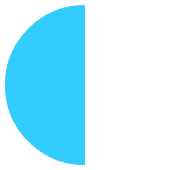
I have always been interested in the space between painting and animation. The concentration of painting, the liveliness of the moving image. I operate in the area between those two.
Our relationship with the moving image is changing. They surround us, a bit more every day.
I imagine we will live in a world where there is no difference between a screen or any other surface. Any surface can change at will.
It is this feeling, or expectation, that drives me to create moving images.
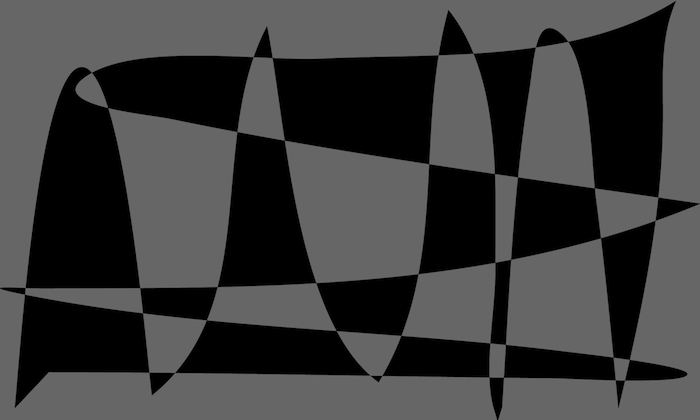
Over the years my work became more abstract. I have no idea why. I have no idea because I have no idea what I’m doing in general. The heart wants what it wants.
An abstract work is a thing, not a picture of a thing. I like both things and pictures of things. Lately I have been making more things than pictures. But it might change in the future. Who knows?
A change of direction is a change of emphasis. There are no absolute directions. There’s always some figuration and there’s always some abstraction.
I follow my interests. I do whatever is most interesting to me at that moment. I don’t have a plan. I’m wandering. I am not in control of my interests. Just think about it… what interests you? Why are you interested in something? Why not something else? I can’t decide where my mind wanders. It would not be wandering if I decided where to go. Wandering is wonderful. You’re just moving around. Not moving to get anywhere, just moving to be in motion.
I like it when I’m somewhere and I’m not thinking too much. Just observing, not making any decisions. Kind of bored and staring at something, looking around, until something presents itself. These moments are the starting points of my work. Whether the work is abstract or figurative, they come from the same “state-of-mind”.
I’m interested in the space between Almost Nothing and Hardly Anything. Something non verbal, sub conscious, non intelligent, not-thinking-too-much. The ideas have no intention other than wanting to exist. Something that exists just because it wants to exist.
The following conversation was re-published from the book Spheres by Swiss graphic designer Philippe Karrer. Jürg Lehni and I discuss our shared interest in vector graphics, which are based on mathematically-defined geometrical entities such as lines, circles, and points, in contrast with more commonly used bitmap graphics, in which values are assigned to grids of pixels.

Rafaël Rozendaal: Vectors are based on mathematical equations. The equations are perfect. No matter how we try, we can never render a perfect circle in any medium. And even if we did, our imperfect eyes would not be able to register its perfection. Do we have to accept that such shapes can only exist in our mind?
Jürg Lehni: What a start of a conversation! This distinction between the abstract mathematical formulation of geometric shapes, and their realization into concrete, physical forms is pretty much at the core of my fascination (or shall I say obsession?) with vector graphics. The shift is always there, whether it is illuminated pixels being turned on or off, a mark-making tool being moved by motors, or a laser beam being guided by electronically-moved mirrors, burning a line permanently into a physical surface. What it boils down to is the difference between the abstract idea behind something on one hand, and its concrete form when it becomes reality. Plato’s theory of forms comes to mind, with its ideal or archetypal forms that stand behind and define the concrete, physical things.
Last night I watched this while high, and fuck this guy. Creating
shitty flash animations with abstract colors, and doing the the whole
“It’s an empty room.” artwork bullshit. Again, fuck this guy.
please stop and go get a job. you are annoying.
fuck this asshole This guy can hardly explain his own ideas.
He’s honest. Lazy art… i want to do that
what a load of fucking shite
what the fuck. how does he make a living off that??
What a joke. My buddys toddler has more artistic talent. I sincerely
hope people dont support this pathetic excuse for an “artist”.
shitty haircut
solipsism
what a waste of both resources and time I just took a shit. Is that art?
It is sad that this is considered “art”.
Completely useless What a fucking idiot this guy is cool. i like his stuff.
artsy fartsy unemployed-ey
These arty types all talk in riddles.
This guy has smoked himself retarded
Wtf stunning
If this is your life…then YOUR LIFE IS SHIT!!!!
This comment is art.
its beautiful I walk into public farting in peoples faces. It’s art!
cool story bro, tell it again
i think this is really cool.
If I was high I might enjoy his work, but unfortunately I am sober and
can say with a clear mind that this is complete bull shit
suck a bag of dicks
2deep4you…. but no seriously i agree.
so this faggot gets paid to make fart noise? FUCK THE WORLD
video tittle should be “how to make money by selling internet trolling”
This is so edgy.
Do you even art, bro?
Yes, in fact, I just arted in the bathroom 5 minutes ago.
Composition: the arrangement of elements in time and space.
The browser is very different from other media, especially when it comes to composition. I believe we are at the very beginning of the aesthetic potential of the networked image.
This is an (incomplete) list of compositional characteristics of the browser.
The internet presents artists with challenges, opportunities, and best of all, a lack of history.
The size of a browser can change at any moment. There is no fixed dimension or ratio. Think of an image, that can shrink or expand at any time. Ideally the artwork anticipates every possible dimension. Colors are rendered differently depending on hardware, software and usage. Websites are ubique yet inconsistent in appearance.
There are many kinds of devices. Some have big pixels, some have small pixels. A 1 pixel line on a smartphone is different from a 1 pixel line on an old CRT monitor. The physical experience of each device is unique.
The user is present in the pictorial space. There might be a cursor or finger that can influence the composition. Interaction is not unique to the browser but it is something that is natural to internet users.
Many people at the same time can influence an image. There is a potential for social images that change over time by allowing users to modify an image, like a wikipedia article.
Computers are good at generating random numbers. I’m not sure if those numbers are truly random, but it’s good enough. Each time the artwork is viewed, it can be slightly or dramatically different.
The networked image can keep pulling information from the web. The elements of composition can change all the time, because the web’s content changes all the time.
In the early days of the internet, bandwidth was very limited. This digital frugality created a new visual language.
Browsers do not have the same rendering power as native applications. This is a limitation and an opportunity at the same time. Challenges like these force artists to come up with new solutions.
I work a lot with geometrical images. They are shapes based on mathematical instructions.
You can write down the equation of the circle, and imagine the circle in your mind. In your mind, the circle is absolutely perfect. It is absolutely round.
Unfortunately there is no screen, printer, or natural phenomenon that can render a perfect circle. There will always be some particles bouncing out of place. And even if we did somehow manage to create perfection for a brief moment, our imperfect eyes would not be able to perceive it. Our eyes show us a distorted image that our mind corrects.
Geometrical images are conceptual images, they only really exist in our mind.